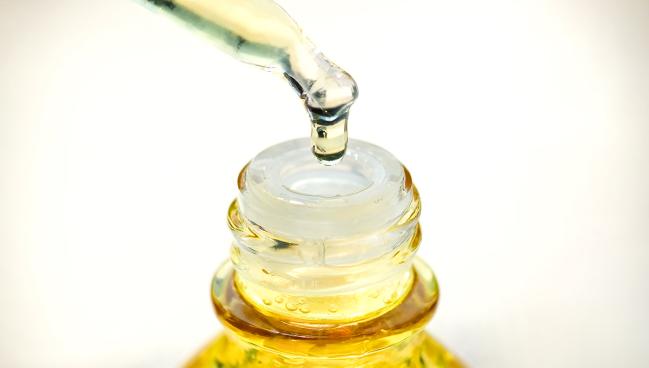New Biomarker Data Again Draw Eyes to Mineral Oil in REDUCE-IT
The placebo group saw rises in Lp-PLA2, IL-6, IL-1β, and other biomarkers. Could this explain the advantage for icosapent ethyl?

Patients in the placebo arm of REDUCE-IT, who received mineral oil, saw worsening levels of numerous biomarkers linked to atherosclerotic disease during the trial, while those in the icosapent ethyl (Vascepa; Amarin) arm saw “minimal changes,” a new analysis shows.
With the pharmaceutical-grade mineral oil, there were increases in interleukin-1β (IL-1β), lipoprotein-associated phospholipase A2 (Lp-PLA2), interleukin-6 (IL-6), lipoprotein(a), and homocysteine. Also increased were oxidized LDL cholesterol and high-sensitivity C-reactive protein (hs-CRP), in line with previously released data.
Thus, by the study’s end, “between-group treatment differences largely reflected increases in the mineral oil group,” Paul M. Ridker, MD (Brigham and Women’s Hospital), and colleagues write in their paper, which was recently published in Circulation.
The findings, obtained from banked blood samples, are fueling a renewed debate on how REDUCE-IT’s choice of placebo should impact interpretation of its data.
REDUCE-IT, presented at the American Heart Association’s 2018 meeting and published in the New England Journal of Medicine, showed that icosapent ethyl, which the body metabolizes into eicosapentaenoic acid (EPA), reduced the relative risk of MACE by 25% in statin-treated patients with high triglyceride levels and either established cardiovascular disease or diabetes plus risk factors.
However, the trial’s positive findings have been dogged by questions over the use of mineral oil, which is said to have proinflammatory effects. Discussion grew even more heated with the STRENGTH trial, testing another omega-3 fatty acid formulation (Epanova; AstraZeneca) against a corn-oil placebo, which was halted due to lackluster results. The chair of STRENGTH’s executive committee went so far as to suggest REDUCE-IT was “a false-positive result.”
If this paper is not explaining the benefit and in fact perhaps raising questions about the placebo, I think the onus is on us to provide some scientific rationale for what’s going on. Deepak L. Bhatt
Deepak L. Bhatt, MD (Brigham and Women’s Hospital, Boston, MA), senior author of the new report and principal investigator of REDUCE-IT, told TCTMD that he remains unconcerned about the biomarker changes.
“I think there’s nothing about these data that should change the confidence one has in the REDUCE-IT clinical trial results and the incremental value of prescription icosapent ethyl,” he said. The newly reported biomarkers tend to correlate with those already reported, LDL and CRP, so it’s no surprise to see them going in the same direction, added Bhatt.
He acknowledged there’s a “potential direct biological effect” of the mineral oil, but cited data to the contrary. Beyond this, though, the biomarker changes could be viewed from two perspectives, Bhatt suggested. It may be that the mineral oil indeed had an adverse impact in the placebo-treated patients. Another possibility, one that he said the trial’s steering committee favors, is that both groups would have seen worsening biomarkers over follow-up but icosapent ethyl in fact stalled this progression among the patients who received it.
Moreover, with the placebo “in many cases the absolute changes in these biomarkers were actually below the lower level of quantification of the particular assay used, so on an absolute scale they were pretty small,” he said. Even if there were some detrimental effects from mineral oil, these wouldn’t be sufficient to explain the reduction in clinical outcomes in the trial, Bhatt said. Instead, he attributed the benefit seen with icosapent ethyl to the “400% increase in EPA levels that the drug produced” between baseline and 1 year.
Dariush Mozaffarian, MD, DrPH (Friedman School of Nutrition Science and Policy, Tufts University, Boston, MA), who served on the STRENGTH trial’s executive steering committee, offered another perspective.
“It’s important because looking at a comprehensive array of objectively measured biomarkers, the only one that meaningfully improved in the intervention group was the LDL cholesterol and many others substantially worsened in the mineral oil group, in particular the inflammatory markers,” he told TCTMD. “So it does suggest that some of the observed benefit wasn’t necessarily from the benefit of the fish oil but the harm of the mineral oil.”
It does suggest that some of the observed benefit wasn’t necessarily from the benefit of the fish oil but the harm of the mineral oil. Dariush Mozaffarian
Mozaffarian said that, when conducting STRENGTH, they “used a very common oil that’s just in the diet of Americans and isn’t going to make a huge difference in the background.” With mineral oil, “there is some evidence [it] might interfere with statin absorption and also potentially have [other] negative effects” related to inflammation and the microbiome, he continued.
What’s worrisome is that the risk represented by the various biomarkers might be additive and account for more of the gap between placebo and icosapent ethyl than would be expected if only a few were elevated, as reported previously in NEJM, said Mozaffarian. The explanation that it comes down to icosapent ethyl having protective effects is also unconvincing, he added. “I looked at CRP and ApoB in the control groups of multiple other large triglyceride trials and they don’t go up in the control group. So I think that’s just not plausible.”
Salim Virani, MD, PhD (Baylor College of Medicine/Michael DeBakey VA Medical Center, Houston, TX), agreed the biomarker changes matter in REDUCE-IT.
“The question in my mind that I cannot fully answer is: is this enough to cause such a large relative and absolute risk reduction that we saw in REDUCE-IT?” he commented to TCTMD, adding: “What proportion can be explained by the modest elevation in LDL cholesterol as well as the elevations that we saw in these inflammatory biomarkers?”
He also pointed out that REDUCE-IT was not the sole trial with EPA to show a benefit, noting that JELIS, as well as the EVAPORATE and CHERRY imaging studies, were positive for EPA.
In Line With Earlier Findings
In REDUCE-IT, the placebo and treatment groups had similar median biomarker levels at baseline. But with mineral oil, there were increases in multiple biomarkers over the subsequent 12 months: 28.9% for IL-1β, 18.5% for Lp-PLA2, 16.2% for IL-6, 2.2% for lipoprotein(a), and 1.5% for homocysteine. Oxidized LDL cholesterol rose by 10.9% and hs-CRP by 21.9%. These changes were maintained at 24 months. With 4 g/day of icosapent ethyl, biomarker levels were largely similar between baseline and follow-up.
By the end of the study, between group differences were significant for all of these biomarkers (P < 0.007), amounting to 2.4% for Lp(a), 3.0% for homocysteine, 4.2% for oxidized LDL, 19.8% for IL-6, 26.2% for Lp-PLA2, 38.5% for hs-CRP, and 48.7% for IL-β.
These data are in line with an earlier look at biomarkers from the trial contained in a supplement accompanying the 2018 NEJM paper. For icosapent ethyl group, that analysis showed decreases of 1.2% in LDL at 1 year and 13.9% in hs-CRP at 2 years compared with baseline. For the placebo group, LDL rose by 10.9% and hs-CRP by 32.3%.
The data themelves provide a clue. Vast majority of the change is between baseline and 12 months. Much less change between 12 and 24 months.
— Venk Murthy, MD, PhD (@venkmurthy) June 29, 2022
Speaking with TCTMD, Bhatt cautioned that not everything they submitted to the journal made it into the published version. He says it’s understandable why some are concerned by the findings, given that there’s an incomplete picture. “I don’t really blame anyone,” said Bhatt. “The way the paper ultimately came out, it’s [more apt] to incite ‘inflammation’ in the community rather than provide any true mechanistic insight.”
For instance, a prespecified analysis that didn’t make the cut compared placebo patients without biomarker changes against the icosapent ethyl group. “Even if we throw out the placebo patients from the trial that had increases in these biomarkers and only looked at the ones that didn’t have increases,” Bhatt explained, “the drug still is superior for reducing cardiovascular events in those patients.”
Mozaffarian said it might be time for the US Food and Drug Administration, which approved icosapent ethyl in late 2019, to ask the drug’s manufacturer for additional information. “When the original paper was published, my hope was that the FDA would not approve it without at least requiring them to do another, smaller trial with a truly inert placebo and just look at biomarkers” in several hundred people, he said. “I wouldn’t have approved the drug without doing that.”
For now, clinicians should follow the FDA’s guidance, with the knowledge that this is an approved agent, Mozaffarian added. “It’s just a question of maybe it’s less beneficial than we think. There’s no evidence for harm.”
Mineral oil had a biological effect, but whether that was sufficient to increase CV risk & by what magnitude is key question. One can do modeling exercise, but it is an exercise in speculation!
— Sanjay Kaul (@kaulcsmc) July 1, 2022
Do we need a tie breaker trial in light of STRENGTH/OMEMI?
RESPECT-EPA?
New? Placebo?
The takeaway, said Virani, is “we’ve got to live with the data we have in terms of making everyday decisions.”
When treating REDUCE-IT-like patients, with either established CVD or diabetes plus risk factors, “first and foremost we need to make sure that all the other therapies we have that have much more consistent evidence without controversy [are] maximized,” said Virani. This includes statin therapy, other cholesterol-lowering medications, and lifestyle factors.
That’s the approach taken by the 2021 American College of Cardiology expert consensus decision pathway for persistent hypertriglyceridemia, led by Virani. “In that pathway, the use of icosapent ethyl is the last step. Before that we have to maximize all these other therapies,” he said, adding, “Once all of that is done and a clinician is still concerned about residual risk after everything else is maximized, it is perhaps reasonable to use icosapent ethyl [based on what we know]. Always be ready to learn more about it. Using it with an open mind and having that conversation with the patient, as well, is probably in my mind the way to go.”
Although for Bhatt the data on EPA are consistent and persuasive, he agreed that it’s worth pursuing clarity. He hopes that, going forward, they will be able to use their banked blood to analyze additional biomarkers that might more directly relate to EPA. “If this paper is not explaining the benefit and in fact perhaps raising questions about the placebo, I think the onus is on us to provide some scientific rationale for what’s going on,” Bhatt concurred.
In their paper, the researchers mention several possible targets for further study. “Specialized pro-resolving and other anti-inflammatory mediators, for example, are powerful anti-inflammatory molecules produced from EPA, and EPA can reduce production of proinflammatory factors from arachidonic acid competitively,” they write. “None of these, however, has been measured in REDUCE-IT; nor have alternative biomarkers such as ceramides and glycoprotein acetylation.”
Robert A. Harrington, MD (Stanford University, CA), in an accompanying editorial, also looks to the future.
“The hard reality is that we are left with uncertainties and the questions raised by use of the mineral oil as placebo can only be answered by another RCT,” he writes. “While this recommendation comes with the acknowledgement of the time, effort, and financial resources required to carry out another trial, it is important from a public health perspective given the large number of high-risk patients that might be considered for treatment with icosapent ethyl.”
Note: When originally published, this story incorrectly listed the icosapent ethyl dose in REDUCE-IT as 4 mg/day. The correct dose is 4 g/day.
Caitlin E. Cox is News Editor of TCTMD and Associate Director, Editorial Content at the Cardiovascular Research Foundation. She produces the…
Read Full BioSources
Ridker PM, Rifai N, MacFadyen J, et al. Effects of randomized treatment with icosapent ethyl and a mineral oil comparator on interleukin-1β, interleukin-6, C-reactive protein, oxidized low-density lipoprotein cholesterol, homocysteine, lipoprotein(a), and lipoprotein-associated phospholipase A2: a REDUCE-IT biomarker substudy. Circulation. 2022;Epub ahead of print.
Harrington RA. Trials and tribulations of randomized clinical trials. Circulation. 2022;Epub ahead of print.
Disclosures
- Ridker has received research grant support from Novartis, Kowa, Amarin, Pfizer, and the National Heart, Lung, and Blood Institute and has served as a consultant to Corvidia, Novartis, Flame, Agepha, Alnylam, IQVIA, RPharma, Horizon Therapeutics, Inflazome, AstraZeneca, Janssen, Civi Biopharm, SOCAR, Novo Nordisk, Uptton, Health Outlook, Omeicos, the Baim Institute, and Boehringer-Ingelheim.
- Bhatt reports receiving research funding or unfunded research support from Abbott, Amarin, Amgen, AstraZeneca, Bayer, Boehringer Ingelheim, Bristol-Myers Squibb, Chiesi, Eisai, Ethicon, Forest Laboratories, Idorsia, Ironwood, Ischemix, Lilly, Medtronic, PhaseBio, Pfizer, Regeneron, Roche, Sanofi, Synaptic, The Medicines Company, FlowCo, Merck, Novo Nordisk, PLx Pharma, and Takeda; being a site co-investigator for Biotronik, Boston Scientific, St. Jude Medical, and Svelte; being a trustee for ACC; serving as an advisory board member, director, or chair for Cardax, Elsevier Practice Update Cardiology, Medscape Cardiology, Regado Biosciences; the Boston VA Research Institute, the Society of Cardiovascular Patient Care, TobeSoft; the American Heart Association Quality Oversight Committee; serving on a range of data safety monitoring committees; receiving honoraria for editorial or committee activities for a range of publications and organizations; and receiving royalties from Elsevier.
- Mozaffarian reports serving on the executive steering committee of STRENGTH and as principal investigator of TRIOLOGY.
- Harrington reports grants to Stanford from CSL Behring.
- Virani reports no relevant conflicts of interest.





Comments